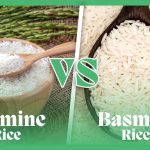In the realm of culinary delights, few staples shine as much as rice, and among them, Jasmine and Basmati outclass others owing to their distinct aroma and flavor. As we step into the tantalizing world of rice, we find ourselves in the middle of a showdown between the two aspiring monarchs of the rice grain.
Stand back, it’s Basmati vs. Jasmine!
Join us as we commence a mouth-watering journey to understand the origin, flavor, health, and nutritional nuances of these flavor-packed grains.
What is Jasmine rice?
Jasmine rice or Asian rice, scientifically known as Oryza Sativa, is originated from Thailand but also grown in Cambodia, Laos, and Vietnam. It was first cultivated in the 1950s in Thailand and is still the prominent export of the country. However, Cambodian rice can give a head-to-head competition to the aroma of Thai jasmine rice.
Jasmine is a long-grain variety that cooks as plump, moist, and sticky with a firm and soft chew. Jasmine rice is also known as aromatic rice as it smells like pandan or buttered popcorn, with a floral and nutty taste. The purest form of this rice is called “Hom Mali” which means “good smelling”. It received the government of Thailand’s appreciation. Jasmine gets its name from the jasmine flower because of its color.
Jasmine rice is a staple throughout Asia but is more common in Southeast Asia, the Middle East, Persia, and Mexico. It is usually served with curries, soups, and traditional wok dishes like krapow and its sticky nature makes it perfect for sushi and sticky rice dishes.

Types:
Jasmine rice is available in various distinct varieties, they are:
White jasmine rice:
The most common variety of jasmine, white jasmine rice, is famous for its floral fragrance and delicate flavor.

Brown jasmine rice:
Brown jasmine rice is the less processed form of rice with a nutty taste and intact bran layer that incorporates more fiber.

Black jasmine rice:
This slightly sweeter black rice also known as “the forbidden rice” turns purple upon cooking.

Red jasmine rice:
Red jasmine rice is similar to brown rice but has a slight reddish hue. This earthy-flavored rice is a whole grain and rich in fiber.

What is basmati rice?
Basmati rice is native to India and Pakistan but is also grown in Indonesia, Nepal, and Sri Lanka. You might see a few Basmati varieties in the U.S. sold as “Texmati” or “Kesmati”, but the traditional basmati rice is grown in the Northern region of India and Pakistan.
The word basmati is derived from a Sanskrit word in which “Vas” means “aroma” and “mayup” means “ingrained or present from the beginning”. When these two words are combined, mayup changes to mati and becomes “vasmati”, which is pronounced as “basmati” which signifies “full of aroma”. Basmati is a long, thin grain with tapered edges that has a nutty taste with a tinge of floral notes. The grain becomes fluffy when cooked and stays separated nicely. The size of the grain increases with cooking, so it goes well with curries and dal.
According to NYU’s Centre of Genomics and Systems Biology, basmati is a hybrid of two kinds of rice, japonica- the rice from East Asia, and ‘aus’ found in Bangladesh.

Types:
White basmati rice:
White basmati is the most common type in stores and is aged for months to bring out the aroma and flavor.

Brown basmati rice:
Brown basmati rice is less processed with a nuttier taste, has a bran layer intact, and contains a good amount of dietary fiber.

Golden Sella basmati:
Golden Sella is a parboiled basmati that maintains its gold shade after cooking. It has a firm texture and is famous for its low Glycemic index.

Wild basmati:
Wild black basmati is the whole grain variety of the basmati and has an exotic flavor.

Difference between basmati and jasmine:
Basmati and jasmine differ in four categories: texture, flavor, molecular structure, and cooking time.
Texture and flavor:
Jasmine rice has a soft and plump texture, with the grains sticking together when cooked. They also impart a sweet taste and plant-like smell.
Basmati rice is a variety with long and slender grains, has a nutty flavor, and gives out a floral aroma when cooked. Its smell is lighter and less noticeable.
Cooking time:
Jasmine rice has a soft texture and requires less cooking time with no soaking before cooking- 1 ¼ cups of water for 1 cup of rice is enough. They are steamed right after rinsing.
Basmati rice is a tough variety and requires soaking for 30 minutes before boiling. When cooked, their size expands to two to three times its original length as opposed to jasmine.
Molecular structure:
Jasmine rice has a high content of starch amylopectin and low amylose; the high amylopectin makes the rice stickier. On the other hand, basmati rice is abundant in amylose, preventing gelatinization in cooking that allows the rice grains to remain separate.
So, the question springs up: Which type of rice to choose when cooking? Pick jasmine when aiming for a fluffy and creamy dish and basmati in pilaf, salad, and grain bowl where you wish for the texture to shine.
Nutritional composition:
The detailed nutritional composition of both jasmine and basmati rice is written as follows:
Jasmine rice:
1 cup of jasmine rice provides 205 calories and 4.5 grams of protein. The 45g carbohydrates in jasmine contain 0.6 g of fiber and 0.1 g of sugars. The aromatic jasmine rice is low in total fats providing about 0.4 g in 1 cup.
Sodium, calcium, Iron, and Potassium are some of the micronutrients found in Jasmine rice.
| Nutrients (1 cup) | Amount |
|---|---|
| Calories | 205 |
| Carbohydrates | 45 g |
| Fiber | 0.6 g |
| Sugar | 0.1 g |
| Protein | 4.3 g |
| Total fats | 0.4 g |
| Saturated fats | 0.1 g |
| Polyunsaturated fat | 0.1 g |
| Monounsaturated fat | 0.1 g |
| Sodium | 1.6 mg |
| Calcium | 16 mg |
| Iron | 1.9 mg |
| Potassium | 55.3 mg |
Basmati rice:
The nutritional composition of basmati rice is not vastly different from that of jasmine. One cup of basmati provides 210 calories, 4g of proteins, and 0.5 g of fats. 46 g of carbohydrates contain 0.7 g of fiber in the basmati.
Besides the macronutrients, the major micronutrients available in basmati are Sodium, Calcium, Iron, and Potassium.
| Nutrients (1 cup) | Amount |
|---|---|
| Calories | 210 |
| Carbohydrates | 46 g |
| Fiber | 0.7 g |
| Protein | 4 g |
| Total fats | 0.5 g |
| Sodium | 2 mg |
| Calcium | 16 mg |
| Iron | 2 mg |
| Potassium | 56 mg |
Role in human nutrition:
Basmati rice:
Basmati rice, especially the brown variety, provides significant health benefits to the body. Some of them are addressed below:
Low in arsenic:
Basmati rice from India and Pakistan has some of the lowest quantities of arsenic- a metal that increases the risk of diabetes, cardiovascular diseases, and cancers.
Remember that the outer bran layer of brown rice tends to be higher in arsenic than white rice.
Diabetes prevention:
Are you diabetic and have been advised to cut rice off of your diet altogether? Well, worry not! brown basmati rice is here to your rescue.
Brown basmati has a low glycemic index and does not cause a sudden spike in blood sugar levels. The glycemic index is the rate at which the food makes your blood sugar rise, so the GI of basmati falls between low to medium GI i.e. 50 to 58.
Weight loss:
Brown basmati is rich in fiber that helps slow down digestion as it breaks down gradually in the body. The fiber provides bulk to the food that passes the digestive system slowly, hence keeping one full for a long time and aiding in weight loss.
Digestive health:
The fiber in the basmati is helpful for the gut as it is high in fiber and keeps the microbiota and gut healthy.
Heart health:
Whole grains like brown basmati rice help lower cholesterol levels, subsequently reducing the risk of heart disease.
The potassium and magnesium content in the basmati also helps decrease blood pressure, a principal risk factor for cardiovascular diseases. Potassium calms the blood vessels, enhances blood flow, and improves the overall blood circulation in the body.
Brain health:
Basmati rice is a good source of B vitamins, particularly vitamin B1 (thiamine). Thiamine is crucial for brain health and its deficiency leads to Wernicke encephalopathy.
Cancer prevention:
Brown basmati rice has about 20% more fiber than other brown rice types, which may help reduce the risk of cancer, especially colorectal cancer. Studies suggest that consuming 3 ounces of whole grains per day may lower your risk of colorectal cancer by 17%.
Essential amino acids:
Amino acids are the building blocks of proteins. Essential amino acids are the type of amino acids the body cannot produce and have to be taken in by diet.
Out of 9, eight essential amino acids are found in basmati that provide energy to the body, build up tissues, boost the immune system, build muscle, and maintain healthy skin, hair, and nails.
Jasmine rice:
The flavorful Jasmine rice provides essential health benefits to the human body. These include:
Better immune system:
Jasmine rice, particularly the colorful varieties like red, black, and purple, is rich in phytonutrients and antioxidants. They help protect body cells and improve the body’s immune system, thereby reducing the risk of major chronic diseases such as cardiovascular disorders and cancers.
Healthy pregnancy:
Folic acid intake is positively associated with healthy pregnancy, especially before pregnancy and the first trimester. Jasmine rice is a good source of folic acid that may help prevent birth defects and neural tube defects. So if one wishes to conceive or have a healthy pregnancy, try adding sticky rice to your diet.
Digestive health:
Brown jasmine rice is less processed than its white counterpart. The bran layer of brown jasmine contains dietary fiber and other essential nutrients. Fiber helps improve digestive health by keeping the gut healthy and normalizing bowel movements.
Fiber is a nutrient that is not only responsible for better digestion but is famous for controlling blood sugar levels, reducing cholesterol, and managing body weight.
Bone health:
Jasmine rice contains calcium, which is crucial for healthy bones and teeth. Calcium also aids in blood clotting and transmits nerve signals.
Cancer prevention:
Whole grains help combat major chronic diseases, among which cancer is one. Brown jasmine rice is protective against colorectal cancer, ovarian cancer, and breast cancer.
Side effects:
Basmati rice:
Excess consumption of all types of food contributes to side effects. Some of the adverse effects of the basmati are:
High glycemic index:
Although we discussed earlier that brown basmati has a low to medium glycemic index recommended for diabetes patients, however, white basmati is highly processed and falls in the category of high glycemic index foods. This high GI may make white basmati unsuitable for diabetic and pre-diabetic patients.
Another reason white basmati may not be suitable for diabetes type 2 is that they are stripped of essential nutrients during processing, and consuming refined grains may produce a sudden spike in blood sugar levels.
Anti-nutrients:
Rice in general including basmati is high in anti-nutrients such as phytic acid and phytates. These anti-nutrients bind with the essential minerals calcium, iron, and zinc in the food and prevent their absorption. The best way to reduce the levels of these phytates is to soak the rice in water before cooking.
High metabolic syndrome risk:
Consuming white rice regularly may put you at risk of developing metabolic syndrome. It is identified by high blood pressure, obesity, low levels of HDL, and high triglycerides. These factors lead to stroke, heart disease, and type 2 diabetes.
Jasmine rice:
Regular consumption of jasmine rice may exert some negative effects on the body:
High blood sugar:
Jasmine rice, especially the white one is high in glycemic index that may cause a sudden spike in blood sugar. Regular consumption of white jasmine may put you at risk of type 2 diabetes.
High arsenic:
Jasmine rice is high in arsenic- a toxic metal found in soil, rocks, and water. The Food and Drug Administration currently does not have the cut-off value for arsenic, but rice can build up ten times more arsenic than other grains as it is grown in water fields.
The high arsenic levels may put the children and even the unborn kids at risk of diseases. The best way to get rid of arsenic is by washing the rice thoroughly before cooking.
Cooking of jasmine and basmati rice:
The cooking of these rice varieties depends on what kind of dish you are hoping for. If you want something drier and firmer- hey, basmati!
But if you wish for a softer and creamier rice base that may go well with soups, jasmine is there for you.
The different textures and starch content provide instructions on how to cook each rice variety.
To cook basmati, soak them in water for 30 minutes before boiling, and add your favorite spices like saffron, cinnamon, and bay leaves. You can pair the basmati with proteins and sauces to bring out the nuttiness of the grain. Basmati rice holds its fluffiness and maintains its grain shape, making it suitable for chicken and lamb biryani.
For jasmine, rinsing it until the water is not cloudy before cooking will bring out its sticky nature and popcorn-like taste. It is apt for soups, stews, seafood, and a side to vegetables rather than with proteins.
There are two ways to cook these rice types. They are discussed ahead:
1. Stovetop:
The guidelines for cooking rice on a stovetop are:
Basmati: 2 cups of water for every cup of rice.
Jasmine: 1 ½ water for every rice cup.
2. Rice cooker:
A rice cooker is the more efficient way to cook rice. Some of the ratios are:
Basmati: 1 ½ cups of water for every cup of rice
Jasmine: 1 cup of water for every rice cup.
Tips for buying and storing basmati and jasmine:
Buying the rice:
Basmati and jasmine are usually located in the bulk bins, grain section, and international aisle of grocery stores. They are sold in various sizes of bags varying between 1 to 20 pounds and also come in bulk packages.
While buying basmati, look for high-quality rice with long grains that are slightly tapered at the end and golden in color. The gold color shows the rice has been properly aged and drier for better cooking results.
For jasmine rice, choose the ones that are 100% originated from Taiwan as they are the most fragrant. Also, check the packaging date for fresh rice as jasmine loses its aroma over months, so if you don’t regularly cook it, do not buy bulk packages.
Storing the rice:
Basmati rice can be stored in a cool and dry place in its packaging for up to a few months, but if you aim to stock it for a longer time, place the packaged rice in an airtight container and store it in a dry place.
Jasmine can be stored in its original packaging and a plastic bag in an airtight container. Try to use jasmine rice within a month or two after buying it, as it loses its aroma upon prolonged storage.
Recipes:
Let’s discuss some delicious recipes you can try from basmati and jasmine rice when you have time.
Basmati rice recipes:
Lamb biryani:
If you are a fan of South Asian dishes, chances are you have had it at least once, if not, you are missing out!
Biryani is a famous rice and meat dish originated from the Indian subcontinent, in which marinated meat is layered with basmati and flavored with herbs, saffron, and garam masala.
Simple basmati rice:
Simple basmati rice is made with only four ingredients within 30 minutes. All you need are rice, oil/butter, salt, and water; your simple fluffy basmati rice is ready to be paired as a base for proteins and vegetables and can be eaten on its own.
Basmati rice pilaf:
Do you sometimes wish for a dish that is more flavorful and aromatic? Try cooking basmati with onion and garlic, and finish it by cooking it in stock.
You can top the pilaf with minced chives and almonds for an extra crunch and flavor or serve it with a lean chicken piece.
Chicken fried rice:
Are you sometimes busy and want to make an easy-to-cook recipe that takes 20 minutes?
Then try this easy chicken fried rice; toss your favorite and available ingredients like onions, carrots, Peas, eggs, garlic, chicken pieces, and cooked rice. Drizzle with some soy sauce, mix, let it cook. Take the rice out on a plate; your quick fried rice is ready.
Curry vegetable basmati rice:
What’s better than a mix of curry and basmati rice? This delicious and nutritious recipe includes beans, peas, peppers, cauliflowers, and your preferred herbs and spices. Curry vegetable basmati rice is a simple and vegan-friendly dish everybody can enjoy.
Jasmine rice:
Let’s come to a few delicious and flavorful recipes of Jasmine rice:
Thai basil chicken and rice:
This famous and easy 15-minute recipe includes garlic, Thai chili, onions, soy sauce, fish sauce, oyster sauce, and basil.
Add ground chicken to vegetable oil and garlic, and break it up with a spoon, fry it for 6-7 minutes. Pour all the sauces, stir fry for two minutes, and add basil leaves. Serve it with plain jasmine rice.
Chinese rice soup:
As discussed earlier, jasmine rice goes well with soups and stews, so this Chinese rice soup is the perfect example.
Combine the rice in the broth with white fish, choy sum, onion, garlic, ginger, sesame oil, and soy sauce, and your warm and hearty bowl of Chinese rice soup is ready!
Simple yellow jasmine rice:
Want to spice up plain jasmine rice without any major ingredients? That’s where yellow jasmine rice makes its appearance. All you require are chicken broth, spices like turmeric, cumin, cinnamon, and bay leaf, and just 5 minutes of your time.
The spices not only enhance the flavor but give the rice a yellow color as well!
One pan of shrimp rice:
Rice and shrimp? Sounds like a perfect combo. Add mushrooms, onions, and peppers to the ingredients, and you get a perfectly nutritious rice meal.
Basic Asian rice porridge:
Rice porridge is a famous comfort food in Asia, made with rice thickened with stocks, meat, and veggies. You can add bone-in chicken and boiled eggs to your rice porridge depending on your taste.
Both basmati and jasmine rice are fragrant foods that offer the desired taste, aroma, and nutritional benefits. The key is to understand the type of rice required for a specific occasion.
So, who wins the rice showdown?
Is it basmati or jasmine? I would say it’s a tie at 50/50!
What’s your opinion? Who do you think is the deserving Monarch of this epic showdown?









